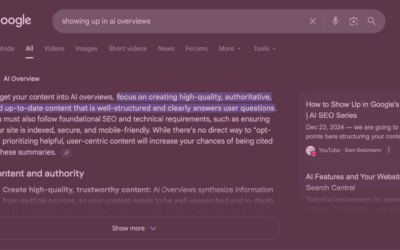Search is changing fast. AI-powered search engines are reshaping how users find info and how brands need to approach digital visibility. This guide covers the strategies, tools, and best practices for winning in this new era of AI search.
What is AI Search Optimization?
AI search optimization is the evolution of traditional SEO adapted for AI-driven search platforms. Rather than just matching keywords, AI search engines understand context, intent, and meaning to deliver more accurate, conversational results.
Understanding AI-Driven Search Engines
AI-driven search engines use large language models and machine learning to grasp user queries at a deeper level. These systems analyze the semantic meaning behind questions, consider user context, and blend info from multiple sources to give full answers. Platforms like Perplexity AI, Google’s AI Overviews, ChatGPT with search, and Bing’s AI Chat represent this new generation of search tech.
How AI Search Differs from Traditional SEO
Traditional SEO focuses on keyword density, backlinks, and technical signals to rank pages in a list of blue links. AI search, however, prioritizes content quality, thoroughness, and the ability to directly answer user questions. Instead of showing ten links, AI search engines often blend info into a single, authoritative response with citations to source material.
The Rise of Generative Search and AI Overviews
Generative search represents a paradigm shift where search engines don’t just retrieve existing content but generate new responses based on indexed info. Google’s AI Overviews, which appear at the top of search results for many queries, show this trend. These AI-generated summaries can significantly impact click-through rates and organic traffic, making optimization for citation and visibility within these overviews essential.
Why AI Search Optimization Matters for Your Business
Adapting to AI search isn’t optional—it’s a must for maintaining digital visibility and competitive positioning in an AI-first future.
Impact on Organic Traffic and Visibility
AI search engines are capturing increasing market share, with millions of users turning to ChatGPT, Perplexity, and AI-enhanced traditional search engines daily. If your content isn’t optimized for these platforms, you’re invisible to a growing segment of potential customers. Early data shows that being cited in AI responses can drive significant referral traffic and establish authority in your niche.
User Behavior Changes in AI Search
Users interacting with AI search show different behaviors than traditional search users. They ask longer, more conversational questions, expect full answers rather than link lists, and trust AI-synthesized responses. Understanding these behavioral shifts helps you create content that works with this new search paradigm.
Competitive Advantages of Early Adoption
Organizations that optimize for AI search now gain first-mover advantages. They establish authority in AI training datasets, build citation relationships, and develop expertise in emerging best practices. As AI search matures, these early investments compound into sustained competitive advantages.
AI Search vs Traditional SEO: Key Differences
Understanding the distinctions between traditional SEO and AI search optimization helps inform strategic decisions.
Algorithm and Ranking Factors
Traditional SEO algorithms emphasize backlinks, domain authority, and on-page optimization signals. AI search prioritizes content accuracy, thoroughness, citation-worthiness, and the ability to directly answer specific questions. While backlinks still matter, they matter differently—as indicators of source credibility rather than popularity.
Content Processing and Understanding
Traditional search engines parse text for keywords and phrases. AI search engines understand semantic meaning, context, relationships between concepts, and even implied info. They can connect ideas across multiple sources and identify the most authoritative info on any topic.
User Experience and Results Display
Traditional search presents ranked lists requiring users to click and evaluate multiple sources. AI search blends info into direct answers, summaries, and conversational responses. This shift means your content needs to be citation-worthy rather than just click-worthy.
Speed and Simplicity Requirements
AI search engines favor clean, well-structured content that’s easy to parse and understand. Complex page structures, excessive JavaScript, and slow loading times create barriers to AI crawling and indexing. Simplicity and speed have become critical optimization factors.
Technical Foundations for AI Search Optimization
Building a solid technical foundation ensures AI crawlers can access, understand, and use your content effectively.
Configure Robots.txt for AI Crawlers
Your robots.txt file controls which automated agents can access your content. AI search engines use specialized crawlers with distinct user-agent strings.
Major AI Crawler User-Agents
Key AI crawlers include GPTBot (OpenAI), Google-Extended (Google AI products), CCBot (Common Crawl), PerplexityBot, ClaudeBot (Anthropic), and various others. Each serves different AI platforms and training purposes.
Blocking vs Allowing AI Access
Blocking AI crawlers prevents your content from being used in AI training and search results. While some organizations block crawlers due to copyright concerns, this approach makes you invisible in AI search. Allowing access positions your content for citation and visibility. Most businesses benefit from allowing AI crawler access while monitoring usage through server logs.
Structured Data and Semantic Markup
Structured data helps AI systems understand your content’s context, relationships, and key info points.
Schema Implementation Best Practices
Implement full schema markup using vocabulary from Schema.org. Include Article, FAQPage, HowTo, Product, Review, and other relevant schemas. Rich structured data helps AI systems categorize your content correctly and extract key info for responses.
Metadata Optimization for AI
Optimize title tags, meta descriptions, and header tags with clear, descriptive language. AI systems use these elements to understand content hierarchy and main topics. Make sure metadata accurately reflects page content using natural language rather than keyword-stuffed phrases.
Site Performance and Speed Optimization
AI crawlers have limited crawl budgets. Fast-loading sites enable more efficient crawling and indexing. Optimize Core Web Vitals, implement lazy loading for images, minimize JavaScript execution time, and use content delivery networks to improve global performance.
Clean HTML and Bot-Friendly Configurations
Use semantic HTML5 elements, maintain logical document structure, avoid excessive DOM depth, and ensure content is accessible without JavaScript execution. Clean markup helps AI systems accurately parse and understand your content.
Creating llms.txt Files
The llms.txt file is an emerging standard that provides AI systems with structured info about your website. Include your site’s purpose, key content areas, preferred citation format, and important URLs. Place this file in your root directory for easy discovery.
API Access and RSS Feed Optimization
Maintain well-formatted RSS/Atom feeds with full content when possible. Some AI systems use feeds for more efficient content discovery. Consider providing API access for structured content retrieval if appropriate for your business model.
Content Strategy for AI Search Success
Content remains king in AI search, but the rules for creating effective content have evolved.
Creating AI-Friendly (Human-Friendly) Content
The best AI search optimization strategy is creating genuinely valuable, human-friendly content. AI systems are trained to identify and prioritize content that serves user needs.
Focus on Unique, Valuable Information
Generic, rehashed content gets ignored. Provide unique insights, original research, specific examples, and perspectives unavailable elsewhere. AI systems prioritize sources that add genuine value to the info ecosystem.
Expert-Driven Content Creation
Content created or reviewed by genuine experts in your field carries more weight. Include author credentials, demonstrate expertise through depth and accuracy, and cite your own experiences and case studies. Expertise, Authority, and Trust (E-A-T) principles matter even more in AI search.
Optimizing for Conversational Queries
AI search users ask questions naturally, as they would to a human expert.
Long-Tail Keywords and Natural Language
Target longer, more specific keyword phrases that reflect how people actually speak. Rather than optimizing for “SEO tools,” target “what are the best SEO tools for small businesses in 2025.” Natural language optimization aligns perfectly with conversational AI search queries.
Question-Based Content Structure
Structure content around common questions in your industry. Use actual questions as headers when appropriate. Create full answers that address follow-up questions users might have. This structure aligns naturally with how AI systems retrieve and blend info.
Structuring Content for Featured Snippets
AI systems often pull info from well-structured, snippet-friendly content.
Clear, Concise Answers Upfront
Place direct answers near the beginning of content sections. Use the inverted pyramid style: answer first, then details. This structure makes it easy for AI systems to extract key info for responses.
Bullet Points and Numbered Lists
Lists format info clearly for both AI systems and human readers. Use numbered lists for sequential steps or ranked items, bullet points for non-sequential info, and consistent formatting throughout your content.
Brief Summaries and Key Takeaways
Include executive summaries, key takeaways sections, and conclusion paragraphs that distill main points. These elements help AI systems identify core info and determine if your content answers specific queries.
Citation Optimization and Source Authority
Being cited by AI systems requires building citation-worthiness into your content strategy. Use credible sources, link to authoritative references, cite specific data and statistics, and maintain accuracy and factual correctness. Building a reputation for reliability increases citation frequency.
Co-occurrence Optimization Strategies
Co-occurrence refers to concepts frequently mentioned together. Identify related concepts, topics, and entities in your niche. Include these naturally in your content to help AI systems understand topical relationships and position your content for broader related queries.
Advanced AI Search Optimization Techniques
Taking AI search optimization to the next level requires understanding sophisticated strategies and emerging technologies.
Leveraging RAG (Retrieval-Augmented Generation)
Retrieval-Augmented Generation is the technology behind most AI search systems. Understanding RAG helps you optimize content for how AI systems actually work. RAG systems retrieve relevant documents, then generate responses based on retrieved info. Optimize for retrieval by using clear topic signals, semantic keywords, and full coverage of subjects.
Multimodal Content Optimization
AI systems increasingly understand images, videos, and other media formats.
Image and Video Optimization for AI
Use descriptive filenames, full alt text, and detailed captions. Include transcripts for video content. Implement image schema markup. As AI vision capabilities improve, visual content becomes increasingly important for search visibility.
Data Visualizations and Infographics
Charts, graphs, and infographics convey complex info efficiently. Make sure these include accompanying text descriptions, cite data sources clearly, and use standard formats that AI systems can interpret.
Local SEO for AI Search
Local businesses must optimize for location-based AI queries. Maintain accurate Google Business Profile info, ensure NAP (Name, Address, Phone) consistency, create location-specific content, and encourage customer reviews. AI systems pull local info from multiple sources to answer location-based queries.
Industry-Specific AI Platform Optimization
Different AI platforms have distinct characteristics and user bases.
Perplexity AI Optimization
Perplexity emphasizes source credibility and citation quality. Focus on authoritative, well-researched content with clear citations. Perplexity users often seek detailed, research-oriented answers.
ChatGPT and SearchGPT Considerations
OpenAI’s search capabilities prioritize recent, authoritative content. Make sure your content stays updated, covers topics fully, and demonstrates expertise. The platform attracts users seeking conversational, detailed explanations.
AI Tools and Modern Tactics for Content Optimization
Using AI tools for your own optimization efforts creates efficiency and insights.
AI-Powered Keyword Research
Tools like ChatGPT, Claude, and specialized SEO platforms identify conversational queries, related concepts, and semantic keyword variations. Use AI to discover question patterns, understand user intent, and find content gaps competitors haven’t addressed.
Content Creation and Enhancement Tools
AI writing assistants help create first drafts, expand sections, and improve clarity. However, always add human expertise, original insights, and fact-checking. AI-assisted content works best when combined with human judgment and expertise.
On-Page Optimization with AI Assistance
AI tools analyze content structure, readability, and topical coverage. They suggest improvements to headers, meta descriptions, and content organization. Use these suggestions as starting points while maintaining authentic voice and valuable insights.
Link Building in the AI Era
Quality matters more than quantity in AI search. Focus on earning links from authoritative sources, creating link-worthy original research and studies, building relationships with industry experts, and developing genuinely valuable resources others want to reference.
Measuring AI Search Performance
Tracking performance in AI search requires new metrics and tools.
Key AI-Centric Metrics to Monitor
Traditional metrics don’t fully capture AI search performance.
Share of Voice in AI Results
Monitor how often your brand or content appears in AI search responses for relevant queries. Track citation frequency compared to competitors. This metric indicates visibility in the AI search ecosystem.
Citation Frequency and Source Attribution
Count how often AI systems cite your content as a source. Note which pages and content types generate the most citations. High citation frequency indicates strong authority and AI search optimization success.
AI Discoverability Metrics
Track AI crawler activity in server logs, monitor indexing rates for new content, and assess how quickly new content appears in AI search results. These metrics reveal how effectively AI systems discover and process your content.
Traditional vs AI Search Analytics
Traditional search analytics track rankings, clicks, and impressions. AI search analytics focus on citations, mentions, and attribution frequency. Both matter, but AI metrics become increasingly important as AI search grows.
Tools for Tracking AI Search Performance
Emerging tools specifically track AI search performance. Monitor server logs for AI crawlers, use AI search query tools to test visibility, and use platforms that track brand mentions across AI systems. The tooling ecosystem for AI search analytics continues to evolve rapidly.
Adjusting Strategies Based on Performance Data
Review performance data regularly, identify high-performing content types, analyze which topics generate citations, and adjust your content strategy accordingly. AI search optimization requires continuous learning and adaptation.
Common Challenges and Solutions
Navigating AI search optimization presents unique challenges requiring thoughtful solutions.
Maintaining Content Quality vs AI Optimization
Never sacrifice quality for optimization. AI systems reward genuine quality, and human readers remain your ultimate audience. Focus on creating valuable content that happens to be well-optimized rather than optimized content that happens to be somewhat valuable.
Balancing Traditional SEO and AI Optimization
You need both traditional SEO and AI optimization. Many users still click traditional blue links. A balanced approach optimizes for current search behavior while preparing for AI-first future. Most best practices overlap, making dual optimization efficient.
Avoiding Over-Optimization Penalties
AI systems detect and penalize manipulation, keyword stuffing, and low-quality tactics. Focus on natural, valuable content. When in doubt, optimize for humans first, knowing that AI systems favor human-friendly content.
Managing Crawler Access and Bot Protection
Balance allowing legitimate AI crawlers while protecting against malicious bots. Use robots.txt thoughtfully, implement rate limiting for aggressive crawlers, and monitor server resources. Most legitimate AI crawlers respect robots.txt directives and crawl respectfully.
Future of AI Search: Trends and Predictions
Understanding emerging trends helps you prepare for what’s next in AI search.
Evolution of Search User Behavior
Users increasingly expect conversational interfaces, direct answers without clicking, and personalized results based on context. Traditional search behavior will persist but gradually decline as AI search improves and gains adoption.
Emerging AI Search Technologies
Multimodal search combining text, images, and voice continues advancing. AI agents that complete tasks beyond just info retrieval are emerging. Real-time, personalized search experiences based on user context and preferences will become standard.
Impact on Traditional SEO Practices
Traditional SEO won’t disappear but will evolve. Click-through rates from traditional search may decline. Citation and authority building become more important than link building alone. The distinction between traditional SEO and AI search optimization will blur as practices converge.
Preparing for AI Agent Computer Use
Future AI agents will interact with websites autonomously to complete tasks. Make sure your site has clear navigation, accessible forms and interfaces, and API endpoints for common tasks. Design for both human and AI agent users.
AI Search Optimization Checklist
Technical Setup Checklist
- Configure robots.txt to allow relevant AI crawlers
- Implement full schema markup
- Optimize site speed and Core Web Vitals
- Create llms.txt file in root directory
- Maintain clean, semantic HTML structure
- Ensure mobile responsiveness and accessibility
- Set up RSS/Atom feeds with full content
Content Optimization Checklist
- Create unique, expert-driven content
- Structure content around common questions
- Use clear headers and logical content hierarchy
- Include brief summaries and key takeaways
- Optimize for conversational, long-tail queries
- Cite credible sources and maintain accuracy
- Update existing content regularly
- Include multimodal elements (images, videos, data viz)
Measurement and Monitoring Checklist
- Monitor AI crawler activity in server logs
- Track citation frequency in AI responses
- Measure share of voice in AI search results
- Analyze which content types generate citations
- Review traditional search metrics alongside AI metrics
- Test content visibility in major AI search platforms
- Adjust strategy based on performance data
Frequently Asked Questions (FAQs)
What is AI SEO and how does it work?
AI SEO is the practice of optimizing content for AI-powered search engines and language models. It works by ensuring your content is accessible to AI crawlers, structured for easy comprehension, and valuable enough to be cited as an authoritative source in AI-generated responses.
How does AI enhance SEO strategies?
AI enhances SEO through improved keyword research, content optimization suggestions, competitive analysis, and performance tracking. AI tools identify opportunities human analysts might miss and process large datasets quickly to inform strategy.
Can AI replace human SEO specialists?
AI cannot replace human SEO specialists but serves as a powerful tool that augments human expertise. Strategic thinking, creativity, relationship building, and understanding business context require human judgment. The most effective approach combines AI efficiency with human insight.
What data does AI analyze for SEO?
AI systems analyze content quality and relevance, structured data and metadata, site performance metrics, user engagement signals, semantic relationships between concepts, source authority and credibility, and freshness and accuracy of info.
How long does it take to see AI search results?
Results vary based on domain authority, content quality, and competitive landscape. Initial improvements may appear within weeks for citation in AI responses. Building sustained visibility typically requires three to six months of consistent optimization. AI search optimization is a long-term strategy requiring ongoing effort.
Should I block or allow AI crawlers?
Most businesses benefit from allowing AI crawlers. Blocking prevents your content from appearing in AI search results and being used in AI training. Unless you have specific legal or competitive reasons to block access, allowing crawlers increases visibility in the growing AI search ecosystem. Monitor crawler behavior and adjust as needed based on your specific circumstances.
Conclusion
AI search optimization represents the future of digital visibility. By understanding how AI systems work, implementing technical best practices, creating genuinely valuable content, and continuously monitoring performance, you position your business for success in this new era. Start with the fundamentals, measure your progress, and adapt as the AI search landscape continues to evolve. The organizations that invest in AI search optimization today will reap the benefits for years to come.



